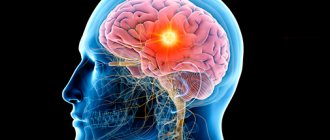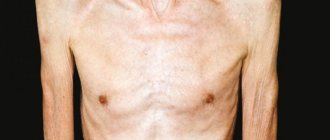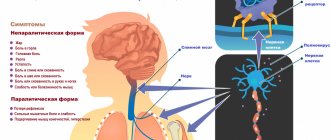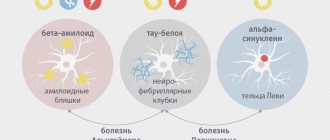Frontotemporal dementia is a neurodegenerative disease accompanied by progressive behavioral and personality disorders. Over time, especially without properly selected treatment, a person completely loses the ability to have full productive contact with others (total dementia). The pathology develops against the background of degenerative changes in the frontal and anterior temporal lobes of the brain. To date, there are no treatment protocols or medications that can be used to cure a person suffering from frontotemporal dementia (FTD), however, doctors at the Leto Mental Health Center will individually select drug therapy that can slow down the progression of severe symptoms.
Classification
In accordance with modern standards of psychotherapy, several forms of frontal dementia are distinguished:
- behavioral with a predominance of personality disorders (occurs most often);
- agrammatic (semantic);
- logopenic (however, according to some experts, this option is rather one of the atypical varieties of Alzheimer's disease).
Atrophy may affect the temporal, frontal, or frontotemporal regions of the brain. The location of the focus is another criterion for determining the form of the disease.
ON THE PROBLEM OF FRONTTEMPORAL DEMENTIA
A. V. Medvedev, N. K. Korsakova, N. P. Shcherbakova, N. Yu. Savvateeva
Scientific Center for Mental Health of the Russian Academy of Medical Sciences, Moscow
We observed 36 patients so-called. “frontotemporal” dementia according to clinical, neuropsychological and CT/MRI criteria proposed by an international research group (The Lund and Manchester Groups, 1994).
The general clinical signs of the disease were: progressive destruction of personality and cognitive functions with loss of critical abilities, loss of socially acceptable forms of behavior, increasing aspontaneity, impulsivity, stereotypies in the absence of pronounced memory impairment and apratic-agnostic disorders.
There were 20 men, 16 women. The average age of onset of the disease was 51.9 years (r=27-69). The average age at the time of the examination was 55.9 years. Noteworthy was the high frequency of family burden (among first- and second-degree relatives) with late-life dementia (11 patients, i.e., reaching 30%). At the same time, in 3 cases (8%) a picture of “frontal dementia” was observed, in 5 (14%) - SDAT, in the remaining 3 (8%) - unclear.
CT/MRI revealed severe combined cortical and central brain atrophy. Cortical atrophy in 11 patients (30.5%) was limited to the frontal lobes, in 6 (16.6%) it also involved the temporal lobes, and in 14 (38.8%) - the temporal and parietal lobes. There were also cases of fronto-parietal (2-5.5%), and isolated temporal (2-5.5%), and temporo-occipital (1-2.7%) atrophy. Central atrophy in 1/3 of patients (12) had a clear accentuation in the anterior parts of the brain.
In the majority of patients (21 people), the picture of dementia was dominated by a gross breakdown of personality and intellect. In other cases (15 people), along with this, progressive speech disorders of the type of dynamic aphasia (up to mutism), sometimes with phenomena of nominative aphasia, were noted.
Certain differences were found between these subgroups of patients regarding the age of onset of the disease, the frequency and nature of hereditary burden of late dementia, and the structure of neuropsychological disorders.
The average age of onset of the disease in patients of the first subgroup was higher than in patients of the second subgroup (53.9 and 49.7 years, p = 0.1546).
The frequency of family history of late dementia was almost twice as high in patients of the first subgroup than in the second (0.39 and 0.2, respectively, p = 0.2330), while cases of “frontal dementia” were found exclusively among relatives of patients in the first subgroup.
According to a neuropsychological study (it was performed in 11 patients of each subgroup), the first subgroup of patients was characterized by a clear predominance of dysfunction of the frontal lobes (in 7 cases), while clear signs of dysfunction of other cortical areas were noted less frequently (temporal - in 4, parietal - at the 1st). In more than 1/3 of cases, accentuation of dysfunction of the right hemisphere of the brain was detected. In the second subgroup of observations, the dominance of frontal lobe dysfunction was noted more than half as often as in the first (in 3 patients out of 11). The majority of patients (8) had combined frontotemporal dysfunction. Mild signs of parietal lobe dysfunction occurred in 2 patients. The majority of patients (8) showed clear signs of dysfunction of the left hemisphere of the brain.
There were no clear differences in the characteristics of brain atrophy according to visual assessment of the results of CT/MRI examination of patients in the first and second subgroups.
The data presented may indicate the heterogeneity of the so-called group. “frontotemporal dementia”, consisting of at least 2 options. One of them is determined by a predominant lesion of the frontal lobe (frontal atrophic dementia in the proper sense), the other is determined by its combination with damage to the temporal region with a predominant involvement of the left hemisphere of the brain (frontotemporal dementia in the proper sense).
Literature.
Clinical and neuropathological criteria for frontotemporal dementia. The Lund and Manchester Groups J. Neurol., Neurosurg. And Psychiatry 1994; 57: 416-418.
Clinical picture
The disease begins between 45 and 70 years , there are no cases of frontotemporal dementia in adolescents (if similar symptoms are present in younger people, a more thorough diagnosis is required, since either hereditary mental illnesses or disorders due to organic brain damage are likely). Symptoms develop gradually.
In the early stages, personality changes predominate, the severity of which depends on the exact localization of the neurodegenerative process. With dementia of the frontal type, the following gradually develop:
- inactivity;
- lethargy;
- absence of external emotional manifestations;
- indifference to everything that happens around;
- reduction and simplification of mental activity,
- slowing, distortion of speech (up to loss of the ability to speak),
- lack of movement, recumbent lifestyle.
When the pathological process is localized in the orbital cortex, the following prevail in the clinical picture:
- loss of sense of tact and distance;
- loss of moral attitudes and principles;
- impulsiveness of actions;
- gross impairments of the cognitive spectrum (the ability to abstract thinking, planning, and performing multi-stage actions is lost), but at the same time memory and orientation in space and the environment are preserved.
Atrophy of the temporal lobes is accompanied by stereotypies - meaningless, illogical repetitions of phrases or individual words, movements, for example, stomping, clapping, rubbing the skin, scratching, pursing lips, smacking, etc. Sometimes obsessive counting appears: the patient constantly counts the number of steps, steps, etc. passed.
In addition, there is a clearly pathological tendency towards cleanliness, which sometimes takes the form of a phobia. Another form of stereotypy is the strictest adherence to an established daily routine, the change of which causes real panic in a person.
In addition, FTD is accompanied by:
- asthenic symptoms (weakness, fatigue, headaches, insomnia);
- movement disorders, muscle rigidity;
- formation of delusional ideas;
- speech disorders (and in 60% of patients they are noted at the initial stage of pathology).
One of the key symptoms is the early loss of the ability to understand and empathize with others' emotions. A person ceases to be interested in the feelings and experiences of those around him (including close people), he is indifferent to the grief of others, which is why the patient usually ends up in social isolation.
Changes in eating behavior are also characteristic. Frontotemporal dementia is typically characterized by an addiction to sweets, or to foods of a strictly specific color, shape, or with a specific smell. The feeling of satiety is lost. In later stages of FTD, the patient may strive to taste any objects, including those that are clearly inedible.
Symptoms
Symptoms of frontotemporal dementia depend on the location of the lesion. On this basis, frontal, temporal and frontotemporal dementia are distinguished.
Important: the main signs of the disease are an imperceptible onset and steady progression. This distinguishes frontotemporal dementia from other presenile and senile dementias.
Frontotemporal dementia ranks second in prevalence among presenile types of degradation. Alzheimer's disease comes first. In the total volume of presenile types of dementia, frontotemporal pathology occupies approximately a fifth part, among all types of dementia – a twentieth part.
Symptoms of frontal lesions
The disease develops when the frontal lobe is predominantly affected. The main symptoms of frontal lobe dementia:
- First, the patient experiences increasing indifference and apathy; general mental and physical activity decreases. The patient moves little and limits communication with others as much as possible; there is a pronounced emotional dullness: everything that previously worried about no longer practically affects. He himself does not show any activity, but is able to show activity under external influence.
When the orbital areas of the cortex are damaged, disinhibition appears, an elevated joyful mood does not depend on external circumstances, tactfulness is lost,
- Frontal lobe dementia in the second stage is characterized by progressive dementia with weakening of higher forms of intellectual activity and personality changes. Speech suffers: the patient at first does not want to speak, and then the so-called “apparent dumbness” sets in. Understanding of oral and written speech is impaired. Characterized by repeated repetition of the same words and phrases (echolalia) and involuntary repetition of movements and gestures of others (echopraxia).
- At the third, final stage, the patient begins to show signs of pseudobulbar palsy: grimacing, forced laughter, crying, grasping and sucking reflexes. Exhaustion gradually develops, the patient does not contact anyone, does not speak, becomes helpless, and the functions of the pelvic organs are disrupted (urinary and fecal incontinence).
As a result, the patient dies from exhaustion and dysfunction of internal organs approximately 10 years from the onset of the disease.
Symptoms of damage to the temporal lobe
Temporal dementia also occurs slowly, with steady progression. The pathological process in this area is characterized by:
- Speech changes at an early stage. Stereotypes of speech, movements and actions appear. The intellect suffers initially, criticism of one’s condition is lost, judgments take on a standard character.
- At the second stage, dementia increases and memory is impaired.
- End-stage symptoms are consistent with other types of frontotemporal dementia.
The difference between the temporal type and the frontal one lies mainly in the early appearance of speech disorders. In this case, memory and thinking may be affected later. The breakdown of speech can reach the point of repeated repetition of phrases, words and syllables (palilalia).
Symptoms of frontotemporal dementia
Combined frontotemporal dementia manifests itself differently, depending on where the underlying pathological processes predominate. The disease may begin with emotional-volitional disorders or speech disorders, but gradually towards the second stage there is a significant decrease in intelligence and a change in personality.
Rarely, symptoms of frontotemporal dementia appear in the form of increased fatigue, depression, headaches, dizziness, and sleep disturbances (drowsiness during the day and insomnia at night). It is also rare that the disease manifests itself from the very beginning in the form of psychotic syndromes: delirium, etc. But despite the atypical onset, subsequently frontotemporal dementia proceeds in a stereotypical manner.
Temporofrontal dementia in adolescents usually begins under the influence of external factors and is manifested by such signs as disinhibition, rudeness, deviant and even delinquent (in violation of the law) behavior, a gradual decline in intelligence, and lag in school. The teenager is tired and unable to cope with school assignments.
Differences between left- and right-sided lesions
When the left or right side of the brain is affected, the symptoms may be different.
The main symptoms of frontotemporal dementia with left-sided and right-sided lesions
| Affected side | Localization in the frontal lobes | Localization in the temporal lobes |
| Left-sided lesion | Lethargy, lack of initiative, irritability, speech impairment in the form of the impossibility of its logical presentation | Lack of emotion, hostility, memory impairment in the form of difficulty in naming objects, impairment in pronunciation of words, speech in the form of stereotypes |
| Right-sided lesion | Lack of criticality, disinhibition, tactlessness, gradual loss of hygiene skills, obsessive actions | Decreased emotionality, mental callousness, antisocial behavior |
The table shows that when the pathological process is localized in the left hemisphere, the disease begins with lethargy and apathy, and with right-sided damage - with disinhibition and loss of communication skills.
Diagnostics
Some symptoms of frontotemporal dementia (delusions, sexual disinhibition, etc.) are typical for other mental illnesses, in particular schizophrenia and Alzheimer's disease. Therefore, doctors at the Leto clinic adhere to the principles of step-by-step diagnosis, excluding all possible diagnoses.
The examination includes the following stages:
- Collection of family history (if necessary, we study outpatient records of the patient’s relatives who have been identified with mental disorders);
- Careful study of the clinical picture. The doctor asks loved ones in great detail about how the disease began, what signs appeared in the first place, how exactly the patient behaves, and how mental and behavioral disorders manifest themselves.
- Instrumental research. A brain tomography is required. CT, MRI and PET-CT (considered the most informative) clearly show signs of selective atrophy.
Cost of services
| CONSULTATIONS OF SPECIALISTS | |
| Initial consultation with a psychiatrist (60 min.) | 6,000 rub. |
| Repeated consultation | 5,000 rub. |
| Consultation with a psychiatrist-narcologist (60 min.) | 5,000 rub. |
| Consultation with a psychologist | 3,500 rub. |
| Consultation with Gromova E.V. (50 minutes) | 12,000 rub. |
| PSYCHOTHERAPY | |
| Psychotherapy (session) | 7,000 rub. |
| Psychotherapy (5 sessions) | 30,000 rub. |
| Psychotherapy (10 sessions) | 60,000 rub. |
| Group psychotherapy (3-7 people) | 3,500 rub. |
| Psychotherapy session with E.V. Gromova (50 minutes) | 12,000 rub. |
| TREATMENT IN A HOSPITAL | |
| Ward for 4 persons | 10,000 rub./day |
| Ward for 3 persons | 13,000 rub./day |
| Ward 1 bed VIP | 23,000 rub./day |
| Individual post | 5,000 rub. |
| PETE | 15,000 rub./day |
This list does not contain all prices for services provided by our clinic. The full price list can be found on the “Prices” , or by calling: 8(969)060-93-93. Initial consultation is FREE!
Treatment of frontotemporal dementia in honey
Therapy mainly comes down to the prescription of general strengthening drugs. These are multivitamin complexes, nootropics, means for normalizing metabolism, cardio- and neuroprotectors. However, the medications listed can only support the functioning of internal organs and systems, and, by and large, do not affect the symptoms of FTD.
The peculiarities of the clinical picture of the disease and the risk of rapid development of total dementia forces doctors to use all the medicinal resources of modern psychiatry and neurology. Thus, according to research, in frontotemporal dementia, drugs used to treat Alzheimer's disease (cholinesterase inhibitors and NDMA antagonists) have a good result.
To correct behavioral disorders the following is prescribed:
- antidepressants (preference is given to drugs from the group of selective serotonin reuptake inhibitors): indicated for anxiety, depression, obsessive disorders;
- neuroliptics and valproates: used for aggressiveness, psychomotor agitation.
Since patients quickly lose the ability to self-care and perform basic daily duties, we offer treatment in a hospital, where patients are provided with round-the-clock care and supervision by qualified medical personnel.
To make an appointment and additional consultation, call us by phone 8(969)060-93-93.
Treatment at the Yusupov Hospital
Frontotemporal dementia is an acquired dementia, which is treated at a high level in the neurology clinic of the Yusupov Hospital. In a multidisciplinary medical institution, patients are offered treatment for the disease according to an individual program, drawn up taking into account the results of complex diagnostics.
Treatment of dementia in the neurology clinic is carried out by doctors of various specializations. The main methods of therapy for frontal lobe dementia are:
- drug treatment;
- psychotherapeutic programs to restore cognitive functions;
- physiotherapy;
- physiotherapeutic procedures.
Patients undergoing treatment at the Yusupov Hospital receive not only high-quality medical care, but also daily care. If your loved ones suffering from dementia need help from an experienced neurologist, make an appointment with us.
Make an appointment









